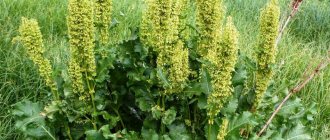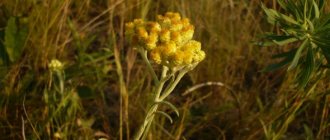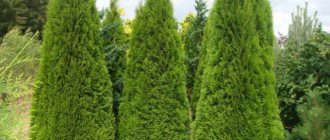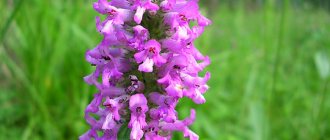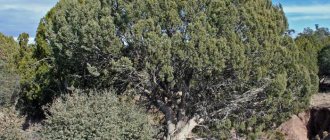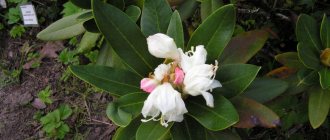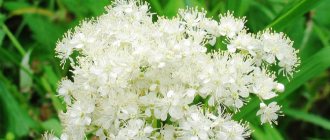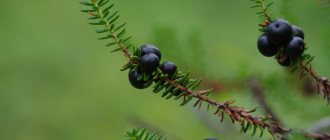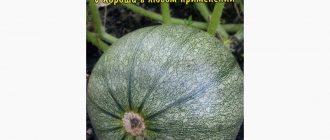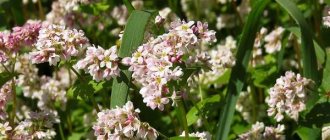Umbrella wintergreen (Chimaphila umbellata) is a perennial subshrub belonging to the heather family. It was first used for medicinal purposes in the 18th century by the Indians, then the indigenous inhabitants of North America. Today, the plant is officially used in the pharmaceutical industry in the USA and Germany, where it is known under the scientific name Chimaphilae herba.
In our country, the winter-loving umbrella plant is still little known, although it is widespread in Altai, the Non-Black Earth Region and the Far East. People call it “lifting grass” or “winter grass” because it is an evergreen plant and does not lose its bright color of leaves even under a thick layer of snow.
Botanical description of wintergreen umbrella
Wintergreen is a miniature plant no more than 25 cm high. It is characterized by a ribbed stem that becomes woody over time and a powerful creeping rhizome. Its shoots are covered with tough, leathery, glossy, pointed foliage with a dark green outer surface, the lower part of the leaves being lighter in color. They have an elongated lanceolate or ovoid shape and jagged edges, their length ranges from 3 to 15, and their width is about 1.5 cm. Fresh leaves, when broken, emit a very strong, pleasant aroma. They have a very interesting sweetish taste with a slight bitterness.
Umbrella inflorescences of winterweed contain up to 7 wide, flat, bell-shaped flowers and pinkish-red color. They have a minty, sweetish aroma. Flowering begins in June and continues until the end of August . After its completion, spherical fruit boxes are formed on the plant, which contain seeds.
Umbrella wintergreen is a perennial subshrub belonging to the heather family.
What does winterweed look like and where does it grow?
Wintergreen is a perennial wild plant of the Heather family, which has a lot of useful properties. It is distinguished by its frost resistance and external resemblance to lingonberries. The winter-loving plant is popularly called the core and spool. The plant has strong creeping roots that allow it to stay on the surface even at low temperatures.
Wintergreen branches at the base. The shoots and stems of the plant are quite strong. Petiolate sessile leaves are small in size. Their width is 2 cm and length is 12 cm. The leaf blade has pointed edges and a leathery surface. Pedicels at the base of the leaves appear in early summer. In length they can exceed the leaf part. The inflorescences resemble the shape of a chamomile. They are distinguished by pinkish petals. 2-8 inflorescences can form on one peduncle. Winter-loving fruiting begins at the end of summer. A small flattened box appears on it, inside which there are black or brown seeds. Its surface is covered with small fibers.
The winter-lover prefers areas with a temperate climate. She feels good in shady coniferous forests. Clay soils and sandstones are considered good environments for plant growth. In Russia, wintergreen is found in the Far East and Siberia. Some species live in Korea, China and Japan. Photo of the winter-loving plant:
During the entire flowering period, it is recommended to cut the leaves of the plant no more than 3 times.
Comment! In some regions, the winter-loving plant is listed in the Red Book.
Places and rules for collecting wintergreen
It is quite difficult to find winter-loving plants in natural growing conditions. But if you manage to do this, then you can collect a large amount of raw materials in one place, since it grows in vast clearings. The plant settles mainly in coniferous forests, especially pine forests, in dry sandy areas.
Since the flowering of wintergreen lasts for a very long time, it can be collected almost throughout the summer. The resulting raw materials should be scattered in a thin layer on clean cloth or sheets of paper and placed in a shaded, well-ventilated place. The grass should be stirred frequently while drying , as thick sheets can quickly rot. You can also dry wintergreen in another way in a special dryer at a temperature not exceeding 40 degrees. The finished raw materials need to be ground, packaged in glass containers, covered with lids or in paper bags; the grass should not be compacted. Send raw materials for storage in a dry, cool room. The beneficial properties of dry grass last for two years.
Also read: Black poplar: medicinal properties and use of sedge in folk medicine
Features of the winter lover
In Russia, the plant has many popular names - winter grass, pear, hogweed, hogweed, core. The perennial winter-loving plant is widespread in Altai and the Far East, and in the Komi Republic it is included in the local Red Book. The plant is found in the Non-Chernozem region. The shrub does not grow in other regions, so its healing qualities are little known.
Botanical description of winterweed
The name wintergreen, translated from the language of indigenous American peoples, deciphers some medicinal properties. The Indians called it “crushing” or “crushing” herb, which indicates the use of medicinal compounds for removing stones from the kidneys and gall bladder.
The Russian names of the grass “winter grass” or “winter grass” reflect the ability of the shrub to retain the bright green color of the foliage even under snow.
A miniature shrub no more than 25 cm high has creeping, powerful roots and creeping stems.
Ribbed woody shoots are covered with tough, pointed foliage of a juicy dark green color.
The upper part of the leathery plate is glossy, the lower part is pale. The shape of the leaves is elongated, lanceolate, with pronounced teeth along the edges.
The length of the plate is from 3 to 15 cm with a width of no more than 2 cm. When broken, the leaves emit a pleasant strong odor and have a sweet taste with a slight bitterness.
Wide, bell-shaped flowers of wintergreen are collected in umbrellas from 2 to 8 pieces. Petals in buds are white-pink, sometimes red.
The flowers have a sweet, menthol aroma. In the conditions of central Russia, buds appear in June and do not disappear until the end of July. After flowering, fruits set in the form of a round flattened box with seeds.
What parts of wintergreen are used for medicinal purposes?
Wintergreen exhibits medicinal properties and contraindications when using all parts of the plant. But it is most rational to harvest young shoots with flowering tops, no longer than 10 cm, or large leaves located at the base of the shoot like whorls.
The tops of the shoots and individual leaves are cut off with scissors or a sharp knife, trying not to disturb the roots of the rare plant. If treated with care, the perennial shrub is completely restored by the next season; cheese can be harvested from one bush many times.
Fresh herbs have a characteristic bittersweet taste and strong odor. Dried raw materials do not smell, but exhibit aroma in infusions and decoctions.
Wintergreen collection
The healing power of the above-ground part of the plant manifests itself during flowering, so the harvesting period is long - up to two months. In most of Russia, the harvest time for insects is in the second half of summer. Due to the limited growing area and the absence of dense thickets, the procurement of large quantities of raw materials is difficult.
Wintergreen is a plant of the northern hemisphere. It is quite difficult to find it on the territory of Russia in the temperate zone. The grass prefers sandy, dry soils of coniferous forests of Siberia and the Far East. Finding clumps of wintergreen is a great success. The rare plant is carefully harvested. When collecting raw materials, it is necessary to leave more than half of the above-ground part for the speedy restoration of the bush.
How to prepare wintergreen
Wintergreen preserves its medicinal properties and contraindications not only in its fresh form. For long-term use, the prepared raw materials should be dried. To do this, lay the shoots on a clean cloth or paper in a thin, loose layer and place them in a shaded place with good air circulation. In the fresh air, with low humidity, you can place the grass under a canopy.
You can prepare wintergreen in special electric dryers, setting the temperature to no higher than 40 °C. High-quality dried raw materials are easily rubbed with your fingers, but do not crumble during storage, the buds retain their shape, the leaves darken a little, but remain green. Dry medicinal herb does not have a distinct odor; the aroma appears when the raw material is brewed.
Storing wintergreen
Crushed raw materials are easier to store and easier to use. The ground dry parts of the plant are poured into hermetically sealed glass or ceramic jars and stored away from sunlight. But such grass quickly loses its healing qualities. For treatment, crushed wintergreen can be used for no longer than 10 months.
Properly dried wintergreen retains its medicinal properties.
By maintaining the integrity of the shoots and leaves, you can significantly increase the shelf life. The dried raw materials are laid out in boxes or linen bags without compaction. It is advisable to provide the plant with good ventilation. This will prevent the dried wintergreen from rotting. These raw materials can be used for treatment for about 24 months.
Decoctions and infusions for treatment are recommended to be prepared before use and not taken after 3 days. Alcohol extracts from wintergreen leaves and flowers have a strong healing effect. Extracts are stored in chemically neutral vessels under tight stoppers in a dark place. Tinctures have a healing effect for more than 3 years.
Gallery: Umbrella wintergreen (25 photos)
Description
Wintergreen is a perennial medicinal plant of the semi-shrub type, no more than 25 cm in height.
The flowers are drooping, pink in color, bloom on long stalks from July to August. After flowering, in September, the fruits ripen - flattened round boxes.
The grass is found predominantly on sandy soil in coniferous forests and nearby areas, surrounded by other shrubs. For medicinal purposes, all parts are collected: roots, stems, inflorescences, leaves. The upper component is cut off during the flowering period. Dry outdoors under a canopy or in special dryers at a temperature not exceeding 50 ºС. It is permissible to store finished raw materials for no more than three years in an airtight container and in a dry place. After this period, it is thrown away so as not to cause harm to health when used.
Beneficial features
Bitter herb has been known for its healing properties since ancient times. This is due to the rich chemical composition, including organic acids, tannins, gums and resins, flavonoids, essential oils, arbutin, quinic and gallic acid, and glycosides. The medicinal properties of the plant include:
- tonic;
- diuretic;
- pain reliever;
- astringent;
- tonic;
- regenerating;
- expectorant;
- diuretic;
- disinfectant;
- astringent.
Foliage and roots help get rid of swelling. Despite the large list of beneficial properties, it has not yet been recognized in official medicine in Russia, as has already been done in Germany and the USA.
In this regard, wintergreen is widely used in folk healing against a whole bunch of problems:
- pathologies of the kidneys and bladder;
- dropsy, swelling;
- fibroids and stomach cancer at an early stage;
- exhaustion, physical overstrain;
- disruptions in the gastrointestinal tract;
- ulcers, gastritis;
- unstable and painful menstrual cycles;
- cystitis, prostatitis, prostate adenoma;
- urolithiasis disease;
- rheumatism, gout, dystrophic changes in joints;
- chronic cough, shortness of breath and other lesions of the upper respiratory tract;
- pulmonary tuberculosis;
- skin diseases, wounds, ulcers, boils, hemorrhoids.
Medicinal raw materials are used in gynecology for cervical erosion, infertility in women and inflammatory processes of the reproductive system. Tinctures and herbal teas help with prolapse of internal organs due to increased physical activity. Infusions and decoctions of the plant can lower blood sugar levels.
Wintergreen infusions are indicated for internal bleeding of any origin: they promote rapid blood clotting and shorten the recovery period.
For women, the herb is invaluable as an aid to weight loss. With regular use of decoctions, a number of positive effects are observed: mood improves, natural complexion returns, excessive appetite is suppressed. This helps you get rid of those hated pounds faster.
Herbal oil is effective in treating any damage to the skin. This led to its use in cosmetology against acne. It is recommended to rub it in for oily and combination skin. This method also allows you to get rid of muscle pain. Thanks to its anti-inflammatory effect, it is gentle on problematic vocal cords.
Composition and medicinal properties of wintergreen umbrella
The chemical composition of the umbrella winterweed includes a large number of the following useful substances:
- Vitamins: A, C;
- Macro- and microelements: potassium, magnesium, manganese, copper, nickel;
- Triterpenoids and glycosides;
- Bitterness and resin;
- Tannins and flavonoids;
- Organic acids and phenols.
Due to the presence of a sufficient number of useful substances in the composition of wintergreen, it can have a wide variety of effects on the body:
- Anti-inflammatory;
- Diuretic;
- Choleretic;
- Antibacterial;
- Astringent;
- Disinfectant;
- Antispasmodic;
- Tonic;
- Painkiller;
- General strengthening.
During drying, wintergreen should be stirred frequently, as thick sheets can quickly rot
Chemical composition of wintergreen
In domestic medicine, the chemical composition of the herb has been little studied, although the population of Altai has been using it for treatment for centuries. The most pronounced effect in the composition of wintergreen is possessed by substances from the class of phenols, which give the plant a characteristic aroma.
Valuable compounds found in the herb:
| Aromatic phenols and derivatives: hydroquinone, chimaphilin, arbutin and others | They affect the kidneys and urinary tract, disinfect, and whiten the skin. |
| Terpenoids: taraxerol, ursolic acid, beta-amyrin | Powerful antioxidants, inhibit tumor growth, increase the production of your own interferon and stimulate the immune system |
| Flavonoids: hyperin, quercetin, avicularin, kaempferol | Regulate metabolic processes, enhance the work of enzymes, heal the liver, strengthen vascular walls |
| Chlorophyll tannins | Stop the reproduction and development of bacteria, remove toxins and poisons from the body, treat the gastrointestinal tract, heal wounds |
| Magnesium, sodium, iron; silicic, sulfuric, phosphoric acids | They nourish muscles (primarily the heart), saturate organs and tissues with essential elements, and participate in many biochemical reactions. |
Wintergreen exhibits medicinal properties and contraindications thanks to its rich composition, which is balanced so that the work of some compounds complements and enhances the effect of others.
The herb contains resins, sugars, bitterness, methyl esters and other valuable components. The nutritional value of the herb has not been precisely determined, but in medicinal doses wintergreen does not have a significant effect on the caloric intake of the diet. The ability of the drug to cleanse the body and stimulate metabolism can be used to reduce excess weight. The rich mineral composition supports the body during diets.
What does winterweed cure for?
The wide range of medicinal properties of wintergreen allows it to be used in the treatment of:
- Ascites;
- Gout;
- Skin diseases;
- Gastritis;
- Stomach ulcers;
- Prostatitis;
- Prostate adenomas;
- Joint diseases;
- Cystitis;
- Liver and kidney diseases;
- Depressive and stressful conditions;
- Rheumatism.
Regular intake of formulations that include wintergreen helps to increase appetite and reduce blood sugar levels, and normalizes the functioning of the food system. With its help, muscle and toothache are relieved, the immune system is strengthened, efficiency is increased, swelling is eliminated, parasites are removed, and wounds heal quickly.
Often they try to use the umbrella plant for weight loss.
Types and varieties
The following types of wintergreen are grown in culture:
Umbrella wintergreen (Chimaphila umbellata)
Or common wintergreen, or wintergreen, or upland wintergreen, or upland wintergreen - a plant of the boreal zone of Eurasia. This is an evergreen low-growing perennial shrub from 5 to 15 cm in height with an erect, woody stem at the base, a short fibrous creeping rhizome with thin roots, short-petiolate leaves collected in a short whorl - thick, leathery, dark green, obovate, with slightly curled serrated edges. The bell-shaped, drooping, wide-open flowers of this species are pinkish in color and are collected in 2-8 pieces in an apical umbel. The fruit of the plant is a spherical capsule, cracking at the edges, with small dust-like seeds.
Japanese wintergreen (Chimaphila japonica)
A species that grows in mossy coniferous forests of the Far East, Korea and Japan. This is a perennial plant with creeping underground shoots, covered with scaly lower leaves, and straight ascending ground shoots 10-15 cm high, on which there are opposite or close together 2-4 short-petioled sharp lanceolate leaves, finely serrated along the edge. The flowers of the Japanese wintergreen are drooping, with a diameter of 13-18 mm. The fruit is a spherical, erect capsule up to 5 mm long.
Features of the use of wintergreen in gynecology
A composition using wintergreen umbrella will be very beneficial for women's health. In gynecology, it is used to normalize the menstrual cycle, and also as a natural hemostatic ingredient for uterine bleeding. also used as a concomitant treatment for uterine prolapse. It is recommended to drink its decoctions or infusions immediately after childbirth to avoid various complications. Wintergreen umbrella is often used in herbal preparations to treat infertility, cystitis and other diseases of the female genitourinary system.
Collection and preparation of grass
The medicinal plant is collected during its flowering period. This happens in the second half of summer. Mainly the above-ground part of the plant is harvested. It is advisable to leave part of the bush so that over time it can recover on its own.
To preserve the medicinal properties of the plant for a long time, the collected stems, leaves and inflorescences are dried. The raw materials are carefully laid out on a flat surface in a ventilated area. It is important to avoid direct sunlight. The recommended drying temperature for the plant is 40-50 °C. The readiness of the raw material is indicated by a change in its structure.
When dried, the plant is stored for 2-3 years, using glass jars or paper bags as containers. For convenience, it is recommended to grind it until smooth. The safety of raw materials ensures compliance with temperature conditions and the absence of exposure to moisture.
Attention! To avoid insomnia, wintergreen decoction should be used no later than 3 hours before going to bed.
Winter-lover in the fight against excess weight
Often they try to use the umbrella plant for weight loss. Indeed, by using products that contain it, you can lose weight, but only by a few kilograms. The result is achieved due to the diuretic properties of the plant, which allow you to quickly rid the body of excess fluid. It is also believed that this herb reduces the percentage of digestibility of fat and sugar, regulates metabolic processes and speeds up metabolism. It should be borne in mind that compositions with winter-loving umbrella plant cannot fight existing fat deposits.
Also read: Lungwort officinalis: decorative and healing properties of the plant
Important! In parallel with taking products based on this plant, you need to follow a diet chosen by a specialist and perform certain physical exercises. This will allow you to achieve maximum effect when losing weight. Treatment should be continued for at least three months, after which a two-month break should be taken.
Caring for winterweed in the garden
Zolotnik is a fairly unpretentious plant that does not require special growing conditions. However, in order for the shrub to be healthy and delight with its strength for several years, when grown in the garden, it should be provided with comfort and proper care.
Watering
Wintergreen grows mainly in mossy areas, so it spends a lot of time in high humidity. However, the plant does not tolerate stagnant water, as the roots quickly begin to rot. The plant should be watered with a moderate amount of clean water. When growing in the garden, gardeners advise adding a small amount of citric acid to the water to strengthen the roots of the plant and saturate it with ascorbic acid.
To prevent burns, water the plant, avoiding water getting on the leaves. immediately after watering, it is necessary to loosen the soil and eliminate weeds growing nearby.
Illumination
Wintergreen grows only in shaded areas with little sunlight. Therefore, in garden conditions, it is necessary to grow the plant in the presence of artificial darkness or near trees and shrubs.
Transfer
Under optimal growing conditions, the winter-loving plant grows in one place for more than 10 years. Therefore, replanting the shrub is not required.
In case of urgent need, the plant is dug up and planted according to the rules specified in the “Planting” paragraph.
soil mixture
The plant predominates in light, well-drained soils. The best solution for growing wintergreens in the garden is a sand mixture. In addition, it is possible to grow wintergreen in a peat-sand mixture. To do this, mix equal parts of peat, sand and humus. A layer of drainage should be placed at the bottom of the plant hole.
Fertilizer
Adult winter-loving bushes do not need fertilizer. However, young bushes should be fed. The plant should be fertilized no more than twice per season. To feed winter-loving plants, you should choose mineral and complex fertilizers. Fertilizers are applied in liquid form under the bush.
In addition, the plant loves organic fertilizers, so the soil in the place where wintergreen grows is dug up with cow or bird droppings.
Traditional medicine recipes
In folk medicine, they use decoctions, infusions, alcohol tinctures, teas, and essential oil of wintergreen.
Infusion
To prepare an infusion of this plant, you need to take 20 g of dry wintergreen herb and steam it with 200 ml of boiling water. The composition must be infused for at least 12 hours. After time has passed, it should be filtered and drunk 1 tbsp. l. three times a day before meals. This infusion can be kept in the refrigerator for up to three days.
Decoction
A decoction of wintergreen umbrella is prepared from 1 tbsp. l. dried herbs and 200 ml of boiling water. The composition must be boiled and simmered on a warm stove for 5 minutes. Drink 1 tbsp. l. 3 times a day before meals.
Juice
The juice is prepared from the freshly collected above-ground part of the Umbrella. The raw materials need to be twisted in a meat grinder and squeezed. Drink 1 tsp of juice diluted in 100 ml of water 2 times a day.
Tincture
For an alcohol tincture, you need to pour 30 g of dry grass into 300 ml of vodka and leave it to infuse in a dark place for 3 weeks. After this, filter the composition and drink 1 tsp with a glass of water 4 times a day before meals.
Wintergreen is considered a valuable medicinal raw material that can easily relieve many health problems.
Tea
To make tea, you need 1 tsp. Brew dried wintergreen umbellata with 300 milliliters of boiling water and leave for about half an hour. After time, filter the broth, heat it and drink it as tea several times a day. You can add a small amount of honey and a slice of lemon to the drink.
Anthelmintic collection
If there is a need to remove parasites from the body, then you do not need to resort to chemicals. To prepare an anthelmintic collection, you need to mix equal parts of dry wintergreen umbrella, upland uterus, wintergreen and berenets. Take 100 g of herbal mixture, add 1 liter of vodka to it and leave for a month in a darkened room. Drink 1 tsp. with half a glass of water or juice half an hour before meals for a month. After a break of two weeks for preventive purposes, repeat the course of treatment.
Also read: Fragrant dill: benefits and uses of the plant
Herbal tea to increase potency
To treat diseases of the male genitourinary system and to increase potency, it is recommended to make the following herbal mixture. In equal quantities, combine dry wintergreen, parsley, motherwort, blackthorn (flowers), wheatgrass (rhizome), asparagus, aspen (foliage), black poplar (buds) and hawthorn (flowers). Take 30 grams of this medicinal mixture, brew 300 ml of boiling water and leave for several hours. Drink 100 ml three times a day before meals.
Wound healing agent
In order to quickly get rid of wounds, as well as the consequences of insect bites, you need to chop 100 g of freshly harvested leaves of the wintergreen umbrella, pour 50 ml of vodka over them and keep them for a month in a dark place. After time, apply the mixture to the affected areas in the form of compresses and wrap with a bandage.
Wintergreen umbrella is often used in herbal preparations to treat infertility, cystitis and other diseases of the female genitourinary system.
Preparations in pharmacies based on wintergreen
The plant is included in the official list of medicines in the USA and Germany, where it is included in antirheumatic drugs and tonic drugs. The essential oil from the plant is popular in the UK. In Russia, wintergreen is not used as a medical raw material. There are no official pharmaceutical preparations from the plant on the Russian market.
The plant is little known in folk medicine outside its growing area. Wintergreen is widely used in Altai and the Kemerovo region. Dried herbs can be purchased in herbal stores and “green” online pharmacies.
Contraindications and side effects of wintergreen
In addition to the beneficial properties, the umbrella plant has contraindications for use and side effects:
- Urolithiasis and cholelithiasis. In this case, due to the strong diuretic effect, stone movement may begin.
- Constipation, hemorrhoids and thrombophlebitis. The astringent properties of the plant can aggravate the situation and lead to more health problems.
- The course of pregnancy and lactation. The beneficial properties and health hazards of wintergreen are not yet fully known. Therefore, you should not risk yourself and your child.
- Any disease in the acute stage
- Individual intolerance and allergic reaction . If, after taking products based on this plant, a rash, itching, headache or other discomfort appears, you should stop taking them.
Since wintergreen is a little-known plant in our country, treatment of various diseases with its use should only be done under the supervision of a qualified specialist.
Best before date
24 months
Vitamins with similar effects
- Wintergreen (Powder for oral use)
- Obivit (Capsule)
- Tincture "Urogin" (Tincture)
- Spruce syrup (Syrup)
- St. John's wort with herbs (Vegetable raw materials)
- Female Doctor (Capsule)
The description of vitamin Wintergreen is intended for informational purposes only. Before starting to use any drug, it is recommended to consult a doctor and read the instructions for use. For more complete information, please refer to the manufacturer's instructions. Do not self-medicate; EUROLAB is not responsible for the consequences caused by the use of information posted on the portal. Any information on the project does not replace consultation with a specialist and cannot be a guarantee of the positive effect of the drug you use. The opinions of EUROLAB portal users may not coincide with the opinions of the site Administration.
Are you interested in the Wintergreen vitamin? Do you want to know more detailed information or do you need a doctor's examination? Or do you need an inspection? You can make an appointment with a doctor - the Euro lab is always at your service! The best doctors will examine you, advise you, provide the necessary assistance and make a diagnosis. You can also call a doctor at home . Euro lab clinic is open for you around the clock.
Attention! The information presented in the vitamins and dietary supplements section is intended for informational purposes and should not be a basis for self-medication. Some of the drugs have a number of contraindications. Patients need to consult a specialist!
If you are interested in any other vitamins, vitamin-mineral complexes or dietary supplements, their descriptions and instructions for use, their analogues, information about the composition and form of release, indications for use and side effects, methods of use, dosages and contraindications, notes about the prescription of the drug for children, newborns and pregnant women, price and consumer reviews, or you have any other questions and suggestions - write to us, we will definitely try to help you.
Medicinal properties, beneficial properties
Preparations prepared on the basis of moth umbellifera have a pronounced anti-inflammatory and diuretic effect. The raw materials of this herb are used for painful uterine bleeding and diseases of the genitourinary system (for example, cystitis and pyelonephritis, catarrh of the bladder, prolapse of the abdomen: uterus or kidneys), edema of various origins, rheumatism, gout, liver diseases, gastrointestinal tract. Fresh crushed wintergreen leaves are applied to wounds, which promotes their healing. The main active ingredients of the plant are: urson (bitterness), arbutin (hydroquinone glycoside), salicylic acid methyl ester, tannins.
Description of the winter-loving plant
A small bush of umbrella winter-loving plant, no more than 20-25 cm high, can be found on sandy soils, often in coniferous forests. The perennial plant has lanceolate-shaped leaves arranged in the shape of spokes from an umbrella. It blooms almost all summer, the flowers are small, pale pink, 5-7 per stem. The color of the leaves is rich green; the leaves themselves are covered with a waxy film, which makes them shine in the sun.
There are several types of wintergreen (umbrella, Japanese, paniculata), which differ not only in appearance, but also in the concentration of active substances. The whole plant has medicinal properties, but it is easiest to harvest the leaves and shoots. The collection of medicinal herbs is carried out at the end of summer, cutting off half of the above-ground part of the plant. It is quite difficult to harvest this plant in large quantities, due to its natural habitat and love of freedom: the shoots do not form large bushes and do not grow in a lush grove.
Diet menu with winterweed
To enhance the weight loss effect, it is recommended to exercise and eat right. At the same time, we advise you to pay attention to a weekly diet that will allow you to cleanse your body of harmful substances and significantly lose weight.
Important: Before each meal you should drink wintergreen tea and any drinks are prohibited for 30 minutes after eating. These products should be divided into three servings per day.
Menu:
- First day - 0.35 kg of low-fat cottage cheese.
- Second day - 0.45 kg of boiled chicken breast or fillet without skin, you need to cook the meat without salt.
- Third day - 8 cups of tea with milk, diluted in a 1:1 ratio.
- Fourth day - 8 pieces of green apples.
- Fifth day - 0.35 kg of any boiled red meat, with the exception of pork.
- Sixth day - grate 5 raw carrots, add 2 tsp to the composition. honey, stir. Divide the resulting mass in half and eat each half for breakfast and lunch. For dinner, boil 3 carrots.
- Seventh day - for breakfast, lunch and dinner, 1 serving of semolina or rice cereal with the addition of a small amount of dried fruits (prunes, raisins).
Collection, preparation and storage of medicinal raw materials
Wintergreen is harvested during the summer months when it blooms. During this period, the concentration of substances in the plant is most suitable for creating medicines. It is recommended to pay attention to the weather forecast: if there is precipitation in the near future, drying the grass will be problematic.
The green part of the wintergreen is cut off with a sharp knife , immediately cutting off and discarding leaves with darkening, signs of rot and disease. Dry the shoots in partial shade or full shade, preferably in the fresh air. To ensure that the plants dry evenly, they are turned over periodically. The best option would be to collect wintergreens in brooms, hung with the cut side up.
When the grass has completely dried, all that remains is to package it in paper or fabric bags: the workpiece must “breathe” fresh air, otherwise mold will not take long to appear. Store dried wintergreen in a dark and ventilated place where there is no moisture. The shelf life under favorable conditions is 2 years from the date of collection.
Contraindications
Wintergreen, like other herbs for weight loss, has a number of contraindications for use:
- pregnancy;
- tendency to constipation, blood clots;
- age under 18 years;
- Excessive excitability;
- high blood pressure;
- diabetes;
- hormonal imbalances;
- heart and kidney diseases;
- diseases of the gastrointestinal tract;
- lactation;
- individual intolerance.
In case of an overdose of the drug, dehydration or an imbalance of water balance in the body may occur, which can lead to problems with the intestines and skeletal muscles.
Before using medicinal herbs, it is recommended to consult a doctor.
Wintergreen for diabetes
A decoction of wintergreen, goat's rue, and mulberry bark will help normalize sugar levels. The drug can be taken at any stage of the disease, combined with drug therapy - the composition is completely safe and does not cause side effects. Step by step recipe:
- Mix goat's rue, wintergreen, mulberry bark (take the components in equal parts, 15 grams each).
- Pour in cool water (500 ml) and leave for an hour.
- Send to high heat, after boiling, simmer at low simmer for a quarter of an hour.
- After straining, bring to the original volume with boiled water.
Take the prepared medicine three times a day, 100 ml. The duration of the course is one month. Take a break and continue taking it after three weeks.
